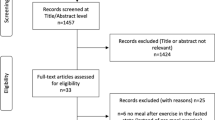Abstract
Serum cholesterol changes after an 8-week behavior modification program for patients with coronary artery disease (CAD) were studied in a randomized controlled clinical trial. Acute myocardial infarction (AMI) or coronary artery bypass grafting (CABG) patients were randomly assigned to the intervention (N = 94) or to usual care (N = 90). After 9 months’ follow-up the intervention was effective in reducing total cholesterol and LDL cholesterol levels, particularly in patients with high baseline lipid levels. After correcting for changes in dose of statins during follow-up, effects were weakened, but for patients with high baseline cholesterol levels favorable effects remained. In these patients, the intervention group showed a decline of total cholesterol and LDL cholesterol levels of 20% and 29%, respectively, compared to a 12% and 19% reduction in the control group (p < .01). These effects could not be explained by changes in dietary fat consumption. An unexpected finding was a lower increase in HDL cholesterol in the intervention group than in the control group.
Similar content being viewed by others
References
Bracke, P. E., & Thoresen, C. E. (1996). Reducing type A behavior patterns: A structured-group approach. In R. Allen & S. Scheidt (Eds.), Heart & mind. The practice of cardiac psychology (pp. 255–290). Washington, DC: American Psychological Association.
Burell, G. (1996). Group psychotherapy in Project New Life: Treatment of coronary-prone behaviors for patients who have had coronary artery bypass graft surgery. In R. Allen & S. Scheidt (Eds.), Heart & mind. The practice of cardiac psychology (pp. 291–310). Washington, DC: American Psychological Association.
DeBusk, R. F., Houston Miller, N., Superko, R., Dennis, C. A., Thomas, R. J., Lew, H. T., et al. (1994). A case-management system for coronary risk factor modification after acute myocardial infarction. Annals of Internal Medicine, 120, 721–729.
Engblom, E., Korpilahti, K., Hämäläinen, H., Puukka, P., & Rönnemaa, T. (1996). Effects of five years of cardiac rehabilitation after coronary artery bypass grafting on coronary risk factors. American Journal of Cardiology, 78, 1428–1431.
Falger, P. R. J. (1989). Life-span development and myocardial infarction: An epidemiological study. Unpublished doctoral dissertation, Maastricht University, Maastricht, The Netherlands.
Feunekes, G. I. J., Van Staveren, W. A., De Vries, J. H. M., Burema, J., & Hautvast, J. G. A. J. (1993). Relative and biomarker-based validity of a food-frequency questionnaire estimating intake of fats and cholesterol. American Journal of Clinical Nutrition, 38, 1–8.
Feunekes, I. J., Van Staveren, W. A., Graveland, F., De Vos, J., & Burema, J. (1995). Reproducibility of a semiquantitative food frequency questionnaire to assess the intake of fats and cholesterol in The Netherlands. International Journal of Food Sciences and Nutrition, 46, 117–123.
Niebauer, J., Hambrecht, R., Velich, T., Hauer, K., Marburger, C., Kälberer, B., et al. (1997). Attenuated progression of coronary artery disease after 6 years of multifactorial risk intervention. Role of physical exercise. Circulation, 96, 2534–2541.
Ornish, D., Brown, S. E., Scherwitz, L. W., Billings, J. H., Armstrong, W. T., Ports, T. A., et al. (1990). Can lifestyle changes reverse coronary heart disease? The Lifestyle Heart Trial. The Lancet, 336, 129–133.
Pfeffer, M. A., Sacks, F. M., & Moyé, L. A. (1999). Influence of baseline lipids on effectiveness of pravastatin in the CARE trial. Journal of the American College of Cardiology, 33, 125–130.
Sacks, F. M., Pfeffer, M. A., Moyé, L. A., Rouleau, J. L., Rutherford, J. D., Cole, T. G., et al. (1996). The effect of pravastatin on coronary events after myocardial infarction in patients with average cholesterol levels. The New England Journal of Medicine, 335, 1001–1009.
Scandinavian Simvastatin Survival Study Group. (1994). Randomised trial of cholesterol lowering in 4444 patients with coronary heart disease: The Scandinavian Simvastatin Survival Study (4S). The Lancet, 344, 1383–1389.
Sebregts, E. H. W. J., Falger, P. R. J., & Bär, F. W. H. M. (2000). Risk factor modification through nonpharmacological interventions in patients with coronary heart disease. Journal of Psychosomatic Research, 48, 425–441.
Van Dixhoorn, J. (1997). Gunstige effecten van adem- en ontspanningsinstructie in de hartrevalidatie: Een gerandomiseerd follow-up onderzoek gedurende 5 jaar [Favorable effects of breathing and relaxation instructions in cardiac rehabilitation: A 5-year randomized follow-up study]. Nederlands Tijdschrift voor Geneeskunde, 141, 530–534.
Van Elderen, T., & Dusseldorp, E. (2001). Lifestyle effects of group health education for patients with coronary heart disease. Psychology and Health, 16, 327–341.
Wageningen University. (1993). VET Expres. De voedselfrequentievragenlijstnaar de vetconsumptie [A food frequency questionnaire estimating the intake of fats]. Wageningen, The Netherlands: Author.
Watts, G. F., Lewis, B., Brunt, J. N. H., Lewis, E. S., Coltart, D. J., Smith, L. D. R., et al. (1992). Effects on coronary artery disease of lipid-lowering diet, or diet plus cholestyramine, in the St Thomas’ Atherosclerosis Regression Study (STARS). The Lancet, 339, 563–569.
West of Scotland Coronary Prevention Study Group. (1998). Influence of pravastatin and plasma lipids on clinical events in the West of Scotland Coronary Prevention Study (WOSCOPS). Circulation, 97, 1440–1445.
Author information
Authors and Affiliations
Corresponding author
Rights and permissions
About this article
Cite this article
Sebregts, E.H., Falger, P.R., Appels, A. et al. Cholesterol changes in coronary patients after a short behavior modification program. Int. J. Behav. Med. 10, 315–330 (2003). https://doi.org/10.1207/S15327558IJBM1004_3
Issue Date:
DOI: https://doi.org/10.1207/S15327558IJBM1004_3




